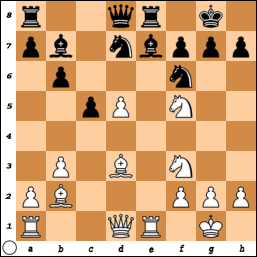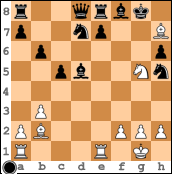I suspect that many of you haven't seen these 2 books. Both were published in 2008, but haven't been widely distributed. They aren't (yet?) available from CMA.

The first is Rampant Chess by Geoff Chandler and Keith Ruxton. It's a collection of 5 games each submitted by 13 Scottish masters. The players featured include well-known GMs such as Aagaard, Rowson and McNab along with less renowned players like Dearing, Muir and McKay.
Instead of just compiling the games and player notes. the authors decided to annotate the games themselves; aiming to do so with a tongue-in-cheek style; both respectful and irreverent.
This familiar approach works well since the book is also a fund-raising effort with all money raised from sales going to Chess Scotland.
The notes are heavier on prose than variations and all efforts were made to entertain and amuse while instructing. You won't see a lot of comments on modern opening theory, but you will find a lot of the authors' personalities invested in the notes and a lot of good-natured ribbing of their famous countrymen.
The games are entertaining and instructive, but national pride and humour take precedence over teaching. Get it to see that chess doesn't have to be deadly serious to be worthwhile. Get it too for inspiration for the "Great Canadian Chess Book" that hasn't yet been written. It would even be an enjoyable project featuring players from a single province.
No publisher is given, but the book was produced through Quality Chess, the firm headed by Scottish GMs Aagaard and Shaw. It's well made and very easy on the eye.
If you want to get a bit of the flavour of Geoff Chandler's writing, you can see a collection of his "Chandler Cornered" articles on the Chess Edinburgh website: http://www.chessedinburgh.co.uk/chandler.php
The second book is Andrew Burnett's "Streetfighting Chess".

This book is a little harder to define. Burnett is an untitled player whose FIDE rating is 2202. His graph shows progress over the last few years and I would put his playing strength as being well higher than his elo would suggest.
He has centred his book around the theme of playing with a streetfighting approach and mindset. Stressing practical considerations over the theoretical, he mainly uses his own games to make his points.
His background is in travel writing and he has a journalism degree, so the quality of the writing is high. In fact, it's a pleasure to read his prose as he communicates clearly and well.
The book is full of very practical and useful advice that most of us could benefit greatly from absorbing. His chapter on Mind-Games alone could justify the book's purchase.
He also backs things up with some pretty good chess. I really like his play and notes from Burnett - MacDonald, Edinburgh 2005. Here's an extract:

"This is the first critical position. Black must decide whether he really wants to take the pawn or not?
If he doesn't, then the pawn could easily become a serious thorn in his side as it is passed and advanced in the heart of his position.
Taking it, on the other hand, is the equivalent of calling your opponent in poker - in effect 'Show me what you've got!'
In his Scotland on Sunday newspaper column, International Master Douglas Bryson states , "Black must try 15) ..., Bf8".
Well, that's fair comment if you've seen the rest of the game, but Black doesn't have that luxury as of yet! Let me just show you one variation I had calculated - totally unforced, but beautiful nonetheless. 15) ..., Bf8 16)Ng5,Bxd5 17)Qh5,Nxh5 18)Nxh6+,gxh6 19)Bxh7#.

(analysis diagram)
As I said, totally unforced, but the fact there are such wonderful tactical possibilities in the position is often a good guide as to how healthy the position is and where you pieces might prove most effective.
I will discuss the idea of fantasy variations again later, but for now let's get back to the game where Black faces a major decision, not the least of which is to avoid horrors like the previous diagram. As we have seen in previous games, defensive choices may be plentiful in number but in practice it will be incredibly difficult to (not to mention tiring and time-consuming) to find what is often a single path to safety through a very scary forest!"
Here's the complete game which is well worth a look!
Burnett,A - MacDonald,C [C10]
Edinburgh, 2005
1.e4 e6 2.d4 d5 3.Nc3 dxe4 4.Nxe4 Bd7 5.Nf3 Bc6 6.Bd3 Nd7 7.0-0 Ngf6 8.Ng3 Be7 9.c4 b6 10.b3 Bb7 11.Bb2 c5 12.d5 exd5 13.Nf5 0-0 14.Re1 Re8 15.cxd5 Bxd5 16.Bb5 Be6 17.Nxg7 Kxg7 18.Rxe6 fxe6 19.Ng5 Nf8 20.Qh5 e5 21.Qf7
+ Kh8 22.Bxe5 h6 23.Bc4 1-0
The entire book is inspirational. Read a couple of chapters and you'll want to rush out and play like Tal or Larsen; 2 of Burnett's heroes. The author's enthusiasm for attacking chess is lovingly infectious. This book will help your play and make you laugh while doing so.
The book is well made and privately published through Burnett's Trinity Knights Publishing.
I got these books from a Scottish company http://www.chesssuppliers.co.uk/
Service was fast, extremely polite and professional. I was charged the equivalent of $70 for both books and shipping. Perhaps CMA might be persuaded to import some?
Both are very attractive to collectors and players. Streetfighting Chess is rumoured to being close to getting snatched up by a mainstream publisher. This would increase the collector's interest in this edition while getting the wider audience it truly deserves. Buy Streetfighting Chess! Hey, get them both!!

The first is Rampant Chess by Geoff Chandler and Keith Ruxton. It's a collection of 5 games each submitted by 13 Scottish masters. The players featured include well-known GMs such as Aagaard, Rowson and McNab along with less renowned players like Dearing, Muir and McKay.
Instead of just compiling the games and player notes. the authors decided to annotate the games themselves; aiming to do so with a tongue-in-cheek style; both respectful and irreverent.
This familiar approach works well since the book is also a fund-raising effort with all money raised from sales going to Chess Scotland.
The notes are heavier on prose than variations and all efforts were made to entertain and amuse while instructing. You won't see a lot of comments on modern opening theory, but you will find a lot of the authors' personalities invested in the notes and a lot of good-natured ribbing of their famous countrymen.
The games are entertaining and instructive, but national pride and humour take precedence over teaching. Get it to see that chess doesn't have to be deadly serious to be worthwhile. Get it too for inspiration for the "Great Canadian Chess Book" that hasn't yet been written. It would even be an enjoyable project featuring players from a single province.
No publisher is given, but the book was produced through Quality Chess, the firm headed by Scottish GMs Aagaard and Shaw. It's well made and very easy on the eye.
If you want to get a bit of the flavour of Geoff Chandler's writing, you can see a collection of his "Chandler Cornered" articles on the Chess Edinburgh website: http://www.chessedinburgh.co.uk/chandler.php
The second book is Andrew Burnett's "Streetfighting Chess".

This book is a little harder to define. Burnett is an untitled player whose FIDE rating is 2202. His graph shows progress over the last few years and I would put his playing strength as being well higher than his elo would suggest.
He has centred his book around the theme of playing with a streetfighting approach and mindset. Stressing practical considerations over the theoretical, he mainly uses his own games to make his points.
His background is in travel writing and he has a journalism degree, so the quality of the writing is high. In fact, it's a pleasure to read his prose as he communicates clearly and well.
The book is full of very practical and useful advice that most of us could benefit greatly from absorbing. His chapter on Mind-Games alone could justify the book's purchase.
He also backs things up with some pretty good chess. I really like his play and notes from Burnett - MacDonald, Edinburgh 2005. Here's an extract:
"This is the first critical position. Black must decide whether he really wants to take the pawn or not?
If he doesn't, then the pawn could easily become a serious thorn in his side as it is passed and advanced in the heart of his position.
Taking it, on the other hand, is the equivalent of calling your opponent in poker - in effect 'Show me what you've got!'
In his Scotland on Sunday newspaper column, International Master Douglas Bryson states , "Black must try 15) ..., Bf8".
Well, that's fair comment if you've seen the rest of the game, but Black doesn't have that luxury as of yet! Let me just show you one variation I had calculated - totally unforced, but beautiful nonetheless. 15) ..., Bf8 16)Ng5,Bxd5 17)Qh5,Nxh5 18)Nxh6+,gxh6 19)Bxh7#.
(analysis diagram)
As I said, totally unforced, but the fact there are such wonderful tactical possibilities in the position is often a good guide as to how healthy the position is and where you pieces might prove most effective.
I will discuss the idea of fantasy variations again later, but for now let's get back to the game where Black faces a major decision, not the least of which is to avoid horrors like the previous diagram. As we have seen in previous games, defensive choices may be plentiful in number but in practice it will be incredibly difficult to (not to mention tiring and time-consuming) to find what is often a single path to safety through a very scary forest!"
Here's the complete game which is well worth a look!
Burnett,A - MacDonald,C [C10]
Edinburgh, 2005
1.e4 e6 2.d4 d5 3.Nc3 dxe4 4.Nxe4 Bd7 5.Nf3 Bc6 6.Bd3 Nd7 7.0-0 Ngf6 8.Ng3 Be7 9.c4 b6 10.b3 Bb7 11.Bb2 c5 12.d5 exd5 13.Nf5 0-0 14.Re1 Re8 15.cxd5 Bxd5 16.Bb5 Be6 17.Nxg7 Kxg7 18.Rxe6 fxe6 19.Ng5 Nf8 20.Qh5 e5 21.Qf7
+ Kh8 22.Bxe5 h6 23.Bc4 1-0
The entire book is inspirational. Read a couple of chapters and you'll want to rush out and play like Tal or Larsen; 2 of Burnett's heroes. The author's enthusiasm for attacking chess is lovingly infectious. This book will help your play and make you laugh while doing so.
The book is well made and privately published through Burnett's Trinity Knights Publishing.
I got these books from a Scottish company http://www.chesssuppliers.co.uk/
Service was fast, extremely polite and professional. I was charged the equivalent of $70 for both books and shipping. Perhaps CMA might be persuaded to import some?
Both are very attractive to collectors and players. Streetfighting Chess is rumoured to being close to getting snatched up by a mainstream publisher. This would increase the collector's interest in this edition while getting the wider audience it truly deserves. Buy Streetfighting Chess! Hey, get them both!!


Comment